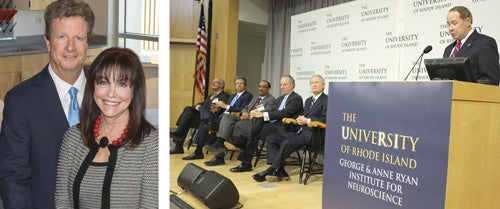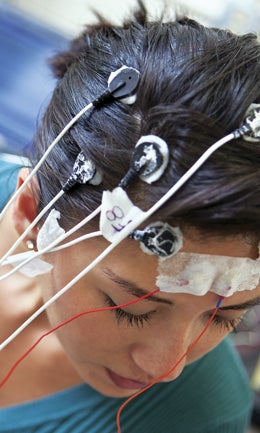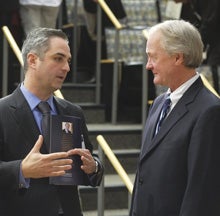Brain Power

Drawing on the expertise of faculty and researchers from URI’s Interdepartmental Neuroscience Program, the Ryan Institute will serve as the coordinating hub for URI’s neuroscience research and educational activities, and will bring even greater funding and focus to these areas.
 On the deck of Tom and Cathy Ryan’s Narragansett home in the summer of 2011, URI President Dave Dooley and Tom Ryan ’75 were earnestly discussing Ryan’s vision and plans for his alma mater. Ryan had made clear his strong interest in the discovery of new cures, drugs, therapies and innovative treatments focused on Alzheimer’s, Parkinson’s, amyotrophic lateral sclerosis (ALS), and traumatic brain injury. Together with Dooley, he was determined to identify an area of scientific study in which URI possessed talent, strength, and potential, and where aggressive progress was not only possible but also probable.
On the deck of Tom and Cathy Ryan’s Narragansett home in the summer of 2011, URI President Dave Dooley and Tom Ryan ’75 were earnestly discussing Ryan’s vision and plans for his alma mater. Ryan had made clear his strong interest in the discovery of new cures, drugs, therapies and innovative treatments focused on Alzheimer’s, Parkinson’s, amyotrophic lateral sclerosis (ALS), and traumatic brain injury. Together with Dooley, he was determined to identify an area of scientific study in which URI possessed talent, strength, and potential, and where aggressive progress was not only possible but also probable.
“When I retired from CVS Caremark two years ago,” says Ryan, who served as the company’s chairman, president, and CEO, “we had conversations about the family foundation’s focus, and we decided to go with education and health care. I had several discussions with President Dooley because, although I had given back to the University in a number of ways, I wanted to give to something that was more transformational, really more of a lasting, future gift.”
“In addition to helping ease the suffering of millions of people around the globe, the George & Anne Ryan Institute for Neuroscience will contribute
significantly to economic development in Rhode Island by creating a vibrant environment for the expansion of basic biomedical research and clinical practice in neuroscience.”
—Governor Lincoln D. Chafee
On November 14, 2013, Tom and Cathy Ryan, with the support of the entire Ryan family, announced an unprecedented $15 million private donation to establish the George & Anne Ryan Institute of Neuroscience at URI, memorializing Tom’s father who died in 2004 from a stroke and resulting Alzheimer’s disease, and his late mother, whose health declined while caring for his father. This is the largest private charitable gift in the University’s history.
“When you look at what’s happening around the world with ALS, autism, epilepsy, Parkinson’s and Alzheimer’s, it’s truly an epidemic,” said Ryan. “As the population ages, not only in the U.S., but globally, it’s going to get worse.”
In fact, with more than 600 known types of neurological disorders, the World Health Organization estimates that one in three Americans is likely to suffer from a neurological disorder. Alzheimer’s alone costs the United States as much as $200 billion per year in direct and indirect health care expenses.
“On a personal level, my dad retired at a young age, was extremely healthy, rock-solid, kind of a bigger than life guy—and he had a stroke and then subsequent Alzheimer’s. I saw what it did to him, what it did to my mother, and our family. The economic costs are one thing, but the personal, emotional costs are another. It steals memories. It saddles caregivers. I saw my mom’s health go down. I had colleagues at CVS pass away from ALS. So it hit close to home for us and—once we did the due diligence and saw what was going on at URI—it was a natural fit.“
And it was a natural fit. The stars had aligned for Ryan and URI. In 2011, expressing its strong commitment to brain-disease research, the University launched the graduate Interdisciplinary Neuroscience Program (INP), with more than 30 faculty in 10 departments and six colleges, including biology, pharmacy, engineering, psychology, communicative disorders, chemistry, and more.
In the meantime, Ryan, a 1975 pharmacy graduate, met with this collection of faculty at URI, with a mission of conducting innovative research to uncover prevention and treatment therapies for neurologically-based and neuropsychiatric disorders, and was fascinated by their work. The toll his father’s disease took on his mother during his father’s declining years was still top of mind. After discussions with Cathy and their family, he decided that a gift to establish an institute of neuroscience could have significant impact in an area important to him and to URI.
“I shared with Tom that ‘with a significant investment on your part, you could in essence accelerate the University’s progress in this area dramatically…this one gift could catapult URI to a position of national prominence in neuroscience research and education,’” Dooley said. “I think Tom found that to be an appealing concept, brimming with potential.”
The George & Anne Ryan Institute of Neuroscience at URI will focus its research, teaching, and outreach on neurodegenerative diseases. Drawing on the expertise of INP faculty and researchers, the Ryan Institute will serve as the coordinating hub for URI’s neuroscience research and educational activities, and will bring even greater funding and focus to these issues.
An additional bonus of this gift: Leveraging URI’s research strengths in pharmacology/drug discovery, neuroengineering, and neuropsychology, the Institute will stimulate cooperation among other institutions in Rhode Island. These include the well-established neuroscience program at Brown University, the basic research programs of the Brown Institute for Brain Science, the newly formed Norman Prince Neurosciences Institute at Rhode Island Hospital that focuses on clinical neuroscience, the U.S. Department of Veterans Affairs, and other regional and national entities working to develop and deliver treatments for central nervous system disorders. The Institute will bring together investigators from various disciplines to create an environment in which those working on molecules or devices, for instance, can partner with those who can test such work in animal or cell culture models and, ultimately, translate such activities into clinical treatments. [See sidebar, next page]
“As CEO of CVS Caremark, Tom was acutely aware that neurodegenerative disease or neurological disorders were an increasingly and rapidly expanding health care problem for the United States and globally,” said Dooley. “As people age and as the numbers of patients expand dramatically, the incidence of disorders around neurodegenerative diseases, neurological degeneration for example, become more common and more difficult to treat. We really need some breakthroughs in this area—from the point of therapeutics—how you treat it, how you diagnose it early enough to actually be effective in your treatments, and how to take steps to minimize the incidence, that is preventive,” he added.
“Neuroscience is one of the last scientific frontiers where fundamental discoveries can still be made,” noted Nasser Zawia, a professor of pharmacology and toxicology, director of the INP and dean of the Graduate School. “This investment could not have come at a more opportune time. Over the last decade or so there have been major advances in our understanding of the brain that have allowed for innovative therapeutic solutions and treatments not possible with our previous limited knowledge.”
This year alone, a national strategy to address these disorders was under discussion in Congress; the White House Office of Science and Technology Policy named its first coordinator of neuroscience research; the Obama administration unveiled a $100 million brain mapping initiative; and the Society for Neuroscience described the coming years as “a period of breakthrough discovery in brain science,” in which the field is “poised to make revolutionary advances.”
“If we do it right and we work together and we increase research dollars, get more faculty, more money in the state, find some cures, some breakthroughs, the economic development will follow,” said Ryan. “But, we’re not doing this for economic development, we’re doing this to try to solve a major problem in this country. And if we do that and do it better than anybody else, we will become the center of excellence, and I think that’s the ultimate goal.
“It’s just the right thing to do, and we think it’s going to make a difference; not only for URI, but for the state, and, ultimately, for society.”
—Linda Acciardo ’77
Powerful Brains
Biomedical engineering Professor Walt Besio’s research will benefit from the establishment of the new Ryan Institute. He has invented an electrode so sensitive that it can translate a person’s thoughts into electrical impulses that can be read by a computer, eventually enabling people who are paralyzed to use their thoughts to control their telephone, television, or other devices in their environment. “The electrode allows me to see things that others haven’t been able to see before,” he said.
Besio’s cutting-edge device automatically cancels noise and can detect brain signals that would not be discernible from noise with currently used electroencephalogram equipment, which has also allowed him to make great strides toward improving the diagnosis and treatment of epilepsy. Unlike existing electrodes, Besio’s invention can precisely pinpoint where on the brain a seizure originates, helping scientists diagnose disease. The electrode can also be used in a therapeutic manner to administer an electrical stimulus to a precise location in the brain to control seizures.
Lisa Weyandt is also studying neurological therapies, but her focus is on the three to seven percent of the school-age population in the U.S. who have been diagnosed with attention deficit/hyperactivity disorder (ADHD), the chronic neurodevelopmental disorder characterized by impulsive behavior, restlessness and an inability to sustain attention. It’s a disorder that the psychology professor says causes academic and social challenges for college students. A leading researcher on the effects of ADHD on young adults, Weyandt is involved in a study of the academic and psychological functioning of college students with ADHD. She also conducted the first clinical trial investigating the effectiveness of the prescription stimulant Vyvanse on college students with ADHD.
Unfortunately, many college-age students who have not been diagnosed with ADHD take medications prescribed for the disorder because they think it will improve their academic performance. It’s a dangerous practice that worries Weyandt. “There are known health risks associated with taking these medications,” she said. “Taking these meds decreases appetite and causes difficulty sleeping, and they’re doing it without scientific evidence that it is truly enhancing their cognitive abilities and academic performance.”
INP Director Nasser Zawia says that the collaborative, interdisciplinary approach URI scientists are taking to address the wide scope of neurological disorders will serve the global community well.
“Figuring out the brain takes a variety of people—engineers, biologists, physicists, chemists. It’s a very complex system, and to understand it, you can’t just study it from the perspective of one discipline,” he said. “Now, with the Ryan Institute, we’re creating an intellectual environment under the umbrella of neuroscience where we can work to solve worldwide problems of health and cognition to better understand the human brain.”
—Todd McLeish
 Home
Home Browse
Browse Close
Close Events
Events Maps
Maps Email
Email Brightspace
Brightspace eCampus
eCampus



